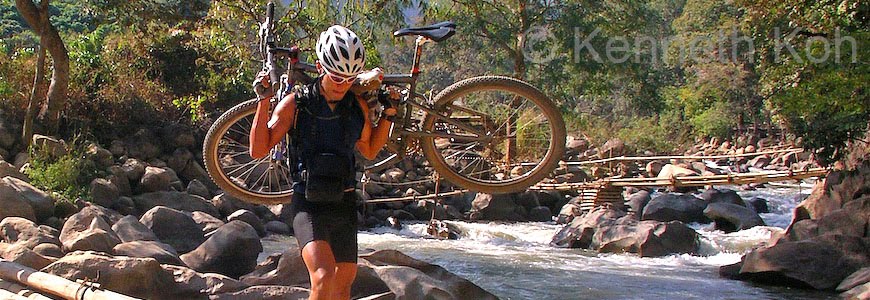 Everest Summiter, Joanne Soo, descending the Low's Peak Circuit via ferrata, Mt. Kinabalu, Malaysian Borneo. Panasonic LX3, 1/500, f/4, ISO 80.
Everest Summiter, Joanne Soo, descending the Low's Peak Circuit via ferrata, Mt. Kinabalu, Malaysian Borneo. Panasonic LX3, 1/500, f/4, ISO 80.There are only 2 serious compact cameras that I considered as a replacement for my compact adventure camera: the Panasonic Lumix DMC LX3 and the Canon G10. While I prefered the control layout and feel of the G10, I chose the LX3 because of its bright f/2.0-2.8, 24-60mm wide-angle to mid-range zoom, similar to what I’d get on a full-frame DSLR with a 24-70mm f/2.8 lens.
 Jack Chen spotting Soo Wan Ming on the 1st ascent(?) of 'Kenneth's Chalk' (V0), Shithouse Boulder, Mt. Kinabalu Summit Plateau. Panasonic LX3, 1/400, f/4, ISO 80.
Jack Chen spotting Soo Wan Ming on the 1st ascent(?) of 'Kenneth's Chalk' (V0), Shithouse Boulder, Mt. Kinabalu Summit Plateau. Panasonic LX3, 1/400, f/4, ISO 80.I’m a little late to the party, but since I’ve put about 3000 frames through this camera, I thought I’d throw in my own totally subjective, non-analytical thoughts into the review mix.
+
Fast, Sharp, Wide, Optically Image Stabilized Leica Lens
The lens on this baby is amazing, and is what makes using this camera a joy. The maximum aperture is f/2 at 24mm: the fastest and widest in its class.
Excellent Image Quality
I guess it’s the combination of the largish sensor, low noise (although I limit mine to ISO 400) and good dynamic range. DSLR quality? Not quite, but at low ISOs, it’s close.
RAW Burst Mode
Up to 3 RAW frames at 2.5 frames per second.
-
There are a few criticisms, but I'm nitpicking ;o)
- Poor Pop-Up Flash Performance
- Slow start up time
- Controls feel cramped
- Joystick too easy to accidentally shift
- Mode Dial too easy to accidentally shift
- Grip too small, slick, and does not feel secure for one handed shooting
- Battery door is flimsy
- LCD hard to read in outdoor sunlight
 Shadow of me photographing Wilfred Tok, owner and operator of Mountain Torq, on the via ferrata cables. Panasonic LX3, 1/500, f/4.5, ISO 80.
Shadow of me photographing Wilfred Tok, owner and operator of Mountain Torq, on the via ferrata cables. Panasonic LX3, 1/500, f/4.5, ISO 80.In The Field
I’ve never used this camera in Manual Mode. I just don’t think the controls are set up well for that. I prefer to use one of the Semi-Auto (A or S Modes) or Program (P) Mode and use the joystick to dial in some exposure compensation, and it works very well like this. Sometimes though, the controls (both the mode dial and the joystick) are a little too easy to shift and I do wish they were a bit stiffer to prevent accidental shifting.
 Panasonic Lumix DMC-LX3 with modified LC-1 lens cap and Lowepro D-Pods 30 case.
Panasonic Lumix DMC-LX3 with modified LC-1 lens cap and Lowepro D-Pods 30 case.Speed of access is important in adventure or travel photography. This is how fast you can get to your camera and take your first shot. I keep my LX3 in a modified Lowepro D-Pods 30
 Jispal Singh and Jack Chen on their way back to the hut after a day of climbing, Mt. Kinabalu, Malaysian Borneo. Panasonic LX3, 1/320, f/2, ISO 80.
Jispal Singh and Jack Chen on their way back to the hut after a day of climbing, Mt. Kinabalu, Malaysian Borneo. Panasonic LX3, 1/320, f/2, ISO 80.In the hand, the camera almost feels ‘too small’ with a miniscule grip, and cramped controls. But if you think about it, that’s what we want, a small compact and lightweight camera. The addition of an optical viewfinder would have been nice, but would have added bulk and weight. Panasonic’s solution is the Auto Power LCD function, which ‘gains up’ the LCD in bright light. It works, but you’ll probably need to remove your sunglasses to see the LCD well.
Useable apertures run from f/2 (f/2.8 at 60mm) to f/8. The sweet spot for maximizing sharpness on this lens is about f/4. Isolating a subject with a nice background blur using a large aperture like f/2.8 is going to be tough - the short focal lengths and small sensor size on small compact cameras combine to give the image a large depth of field. On the flipside, f/8 isn’t really a small enough aperture to give a nice sunstar when shooting into the sun. This is not a criticism, just a limitation of the way these small compact cameras work.
 Making our way down the via ferrata cables to the base of the climb. Panasonic LX3, 1/200, f/8, ISO 80.
Making our way down the via ferrata cables to the base of the climb. Panasonic LX3, 1/200, f/8, ISO 80.Conclusion
The Panasonic LX3 is not the camera for everyone. Some users may prefer a zoom with more reach, but for me the Panasonic Lumix DMC-LX3
Other Notes:
Lens Cap Mod
This uses a modified Ricoh LC-1 Lens Cap
Ian Ho’s method is the easiest, requiring nothing more than forcing the LC1 lens cap through the threads of the LX3, and then using some spacers to hold the flaps out of the way. The method I used was the ‘Chinese’ method, requiring painstaking sanding and cutting away of excess material on the inside of the lens cap. Be careful with this method though, I stabbed myself in the finger doing this, but the final results are the best, with the slimmest profile, does not require any spacers, and does not get in the way of the pop-up flash. If you screw up the ‘Chinese’ method, then you can still do the ‘glue-on’ method, whereby you sand down the LC1 even further, and simply epoxy the LC-1 to the LX3’s screw on mount. This isn’t as slim as the Chinese method, and still requires spacers.





